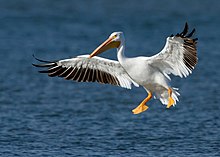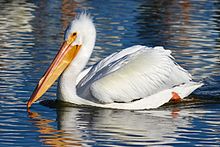American white pelican
| American white pelican | |
|---|---|

| |
| Flying in Dallas, USA | |
| Scientific classification | |
| Domain: | Eukaryota |
| Kingdom: | Animalia |
| Phylum: | Chordata |
| Class: | Aves |
| Order: | Pelecaniformes |
| Family: | Pelecanidae |
| Genus: | Pelecanus |
| Species: | P. erythrorhynchos
|
| Binomial name | |
| Pelecanus erythrorhynchos Gmelin, 1789
| |

| |
Breeding Migration Year-round Nonbreeding
| |
| Synonyms | |
|
Pelecanus erythrorhynchus (lapsus) | |
The American white pelican (Pelecanus erythrorhynchos) is a large aquatic soaring bird from the order Pelecaniformes. It breeds in interior North America, moving south and to the coasts, as far as Costa Rica, in winter.[3]
Taxonomy
The American white pelican was
Description



The American white pelican rivals the
The bill is huge and flat on the top, with a large throat sac below, and, in the breeding season, is vivid orange in color as is the iris, the bare skin around the eye, and the feet. In the breeding season, there is a laterally flattened "horn" on the upper bill, located about one-third the bill's length behind the tip. This is the only one of the eight species of pelican to have a bill "horn". The horn is shed after the birds have mated and laid their eggs. Outside the breeding season, the bare parts become duller in color, with the naked facial skin yellow and the bill, pouch, and feet an orangy-flesh color.[3]
Apart from the difference in size, males and females look exactly alike. Immature birds have light grey plumage with darker brownish nape and remiges. Their bare parts are dull grey. Chicks are naked at first, then grow white down feathers all over, before moulting to the immature plumage.[3]
Distribution and ecology

American white pelicans nest in colonies of several hundred pairs on islands in remote
They winter on the Pacific and
Wild American white pelicans may live for more than 16 years. In captivity, the record lifespan stands at over 34 years.[3]
Food and feeding
Unlike the
American white pelicans like to come together in groups of a dozen or more birds to feed, as they can thus cooperate and corral fish to one another. When this is not easily possible – for example in deep water, where fish can escape by diving out of reach – they prefer to forage alone. But the birds also steal food on occasion from other birds, a practice known as kleptoparasitism. White pelicans are known to steal fish from other pelicans, gulls, and cormorants from the surface of the water and, in one case, from a great blue heron while both large birds were in flight.[3][22]
Reproduction
As noted above, they are colonial breeders, with up to 5,000 pairs per site. The birds arrive on the breeding grounds in March or April; nesting starts between early April and early June. During the breeding season, both males and females develop a pronounced bump on the top of their large beaks. This conspicuous growth is shed by the end of the breeding season.
The nest is a shallow depression scraped in the ground, into which some twigs, sticks, reeds, or similar debris have been gathered. After about one week of courtship and nest-building, the female lays a clutch of usually two or three eggs, sometimes just one, sometimes up to six.
Both parents
-
American white pelican (breeding) in Green Bay, WI, 2013
-
Nest at Chase Lake
-
Adults on their nests, already in nonbreeding plumage (note dark nape)
Predation
Occasionally, these pelicans may nest in colonies on isolated islands, which is believed to significantly reduce the likelihood of mammalian predation. Red foxes and coyotes prey upon colonies that they can access, and several gulls have been known to prey on pelican eggs and nestlings (including herring, ring-billed, and California gull), as well as common ravens. Young pelicans may be hunted by great horned owls, red-tailed hawks, bald eagles, and golden eagles. The pelicans react to mammalian threats differently from avian threats. Though fairly approachable while feeding, the pelicans may temporarily abandon their nests if a human closely approaches the colony. If the threat is another bird, however, the pelicans do not abandon the nest and may fight off the interloper by jabbing at them with their considerable bills.[23] Full-grown pelicans have few predators. Only Red foxes and coyotes are known to prey on nesting adults on rare occasions.[24]
Status and conservation
This species is protected by the
Habitat loss is the largest known cause of nesting failure, with flooding and drought being recurrent problems. Human-related losses include entanglement in fishing gear, boating disturbance, and poaching as well as additional habitat degradation.[25]
There was a pronounced decline in American white pelican numbers in the mid-20th century, attributable to the excessive spraying of
References
- ^ . Retrieved 19 November 2021.
- ^ "Pelecanus erythrorhynchos". Natureserve Explorer. Retrieved 17 April 2024.
- ^ ISBN 84-87334-10-5
- ^ Gmelin, Johann Friedrich (1789). Systema naturae per regna tria naturae : secundum classes, ordines, genera, species, cum characteribus, differentiis, synonymis, locis (in Latin). Vol. 1, Part 2 (13th ed.). Lipsiae [Leipzig]: Georg. Emanuel. Beer. p. 571.
- ^ Latham, John (1785). A General Synopsis of Birds. Vol. 3, Part 2. London: Printed for Leigh and Sotheby. p. 586.
- ^ Mayr, Ernst; Cottrell, G. William, eds. (1979). Check-List of Birds of the World. Vol. 1 (2nd ed.). Cambridge, Massachusetts: Museum of Comparative Zoology. p. 191.
- ISBN 978-1-4081-2501-4.
- Rasmussen, Pamela, eds. (August 2022). "Ibis, spoonbills, herons, Hamerkop, Shoebill, pelicans". IOC World Bird List Version 12.2. International Ornithologists' Union. Retrieved 2 December 2022.
- ISBN 84-87334-20-2.
- ^ ISBN 978-0-8493-4258-5.
- ISBN 978-1-4200-6444-5.
- ^ Dorr, Brian S.; King, D. Tommy; Gerard, Patrick; and Spalding, Marilyn G. (2005) "The Use of Culmen Length to Determine Sex of the American White Pelican". USDA National Wildlife Research Center – Staff Publications. Paper 9.
- ^ Estela, Felipe A.; Silva, John Douglas & Castillo, Luis Fernando (2005): El pelícano blanco americano (Pelecanus erythrorhynchus) en Colombia, con comentarios sobre los effectos de los huracanes en el Caribe [The American White Pelican (Pelecanus erythrorhynchus) in Colombia, with comments on the effects of Caribbean hurricanes]. Caldasia 27(2): 271- 275 [Spanish with English abstract]. PDF fulltext
- ^ Knopf, Fritz L. and Roger M. Evans (2004). "American white pelican - Pelecanus erythrorhynchos". U.S. Fish & Wildlife Service.
- ^ Bent, Arthur Cleveland. Life histories of North American petrels and pelicans and their allies. Vol. 121. US Government Printing Office, 1922.
- ^ "American White Pelican". Truckee River Guide. 24 June 2023.
- ^ a b "Pelecanus erythrorhynchos (American white pelican)". Animal Diversity Web.
- ^ a b BLAIR F. MCMAHON AND ROGER M. EVANS (1992). "NOCTURNAL FORAGING IN THE AMERICAN WHITE PELICAN'" (PDF). Searchable Ornithological Research Archive.
- ^ Montana Natural Heritage Program and Montana Fish, Wildlife and Parks. (2018). "American White Pelican - Pelecanus erythrorhynchos". Montana Field Guide.
- S2CID 85757144.
- ISBN 0-929918-06-1.
- ^ Nesbitt, S.A.; Folk, M.J. (2003). "Kleptoparasitism of great blue herons by American white pelicans". Florida Field Naturalist. 31 (2): 19–45. Archived from the original on 2014-05-03.
- ^ Dewey, Tanya. Pelecanus erythrorhynchos. Animal Diversity Web
- ^ Knopf, F. L. and R. M. Evans (2020). American White Pelican (Pelecanus erythrorhynchos), version 1.0. In Birds of the World (A. F. Poole, Editor). Cornell Lab of Ornithology, Ithaca, NY, USA. https://doi.org/10.2173/bow.amwpel.01
- ISBN 0-7726-7466-3
External links
- "American white pelican media". Internet Bird Collection.
- American white pelican profile (Archived 2014-09-20 at the Wayback Machine) at The Nature Conservancy
- American white pelican pictures from 'Field Guide' page on Flickr
- Stamps (for Turks and Caicos) – with Range Map at bird-stamps.org
- American white pelican photo gallery at VIREO (Drexel University)
- Photos of the American White Pelican by Klaus Nigge
- Interactive range map of Pelecanus erythrorhynchos at IUCN Red List maps





